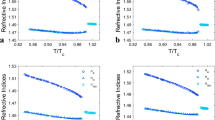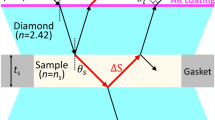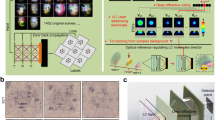Abstract
WE have extended the scope of a method recently described1 for the measurement of refractive indices of liquids in thin films, and have obtained evidence of the double refraction of the interfacial layer between melted normal fatty acids and glass. Acids with more than ten carbon atoms in the chain are being examined. The birefringence is small, usually less than 0.0001, and exists only over a narrow temperature range of a few degrees immediately above the solidification point of the acid. This provides optical evidence that the molecules of the fatty acids are oriented at a glass-liquid interface to a depth comparable with a wave-length of visible light2. The sharpness of disappearance of the birefringence at a critical temperature is thought to indicate that the anisotropic layer is a new phase, and that the fatty acid behaves as a liquid crystal immediately above its solidification point.
This is a preview of subscription content, access via your institution
Access options
Subscribe to this journal
Receive 51 print issues and online access
$199.00 per year
only $3.90 per issue
Buy this article
- Purchase on SpringerLink
- Instant access to full article PDF
Prices may be subject to local taxes which are calculated during checkout
Similar content being viewed by others
References
Taylor and Glover, J. Optical Soc. Amer., 23, June 1933.
Trillat, J. Phys. Radium, 10, 32; 1929.
Author information
Authors and Affiliations
Rights and permissions
About this article
Cite this article
TAYLOR, A., KING, A. Double Refraction of Oriented Surface Layers. Nature 132, 64 (1933). https://doi.org/10.1038/132064b0
Issue date:
DOI: https://doi.org/10.1038/132064b0



